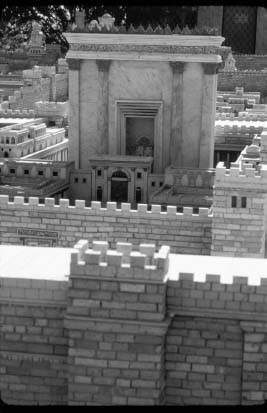JudaismHistory and Sources |
What did the Jerusalem Temple look like? |
Solomon built the first Temple around 950 B.C.E. After that was destroyed in 587/6 B.C.E., it was replaced by the Second Temple in about 516 B.C.E. That in turn was modified many times over the subsequent five centuries, most recently by King Herod. Though the Second Temple was destroyed in 70 C.E., parts of Herod’s construction are still visible as the Western, so-called “Wailing,” Wall. Biblical accounts offer detailed descriptions of various components of the Temple, filling in some of the information archaeology has yet to unearth. Solomon’s Temple was in a way a permanent version of the Tabernacle described in the Torah. A rectangle about two hundred feet long by forty feet wide, the Temple consisted of three chambers. Up a few steps flanked by the two columns symbolic of the monarchs, Jachin and Boaz, and just through the east-facing main door was the vestibule. Beyond that was a large windowed room (the heikhal, “great hall”) where most rituals occurred, and the dark Holy of Holies (devir, “shrine”), elevated five or six steps, which only the priestly staff could enter and where the Ark was kept. Surrounding the central building was a huge courtyard with three gates on each of its four sides. In the Second Temple the central building was larger and set in the grander context of a series of courtyards. Along the walls of the court immediately enclosing the Temple proper were chambers for the sacrificial materials. Directly in front of the Temple porch, in the Court of the Priests, was a large altar for burnt offerings and a small slaughterhouse. Directly east of that, through a gate and down six or eight steps, was the large Women’s Court with corner chambers for lepers, Nazirites, oil, and wood. The Second Temple’s shrine held no Ark of the Covenant. Surrounding the entire high platform was an immense wall, some of which remains today.

Model of the Second Temple, Herodian renovation, showing the forecourts and the main structure that contained the Holy of Holies.
